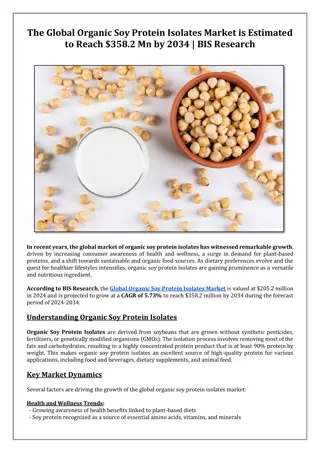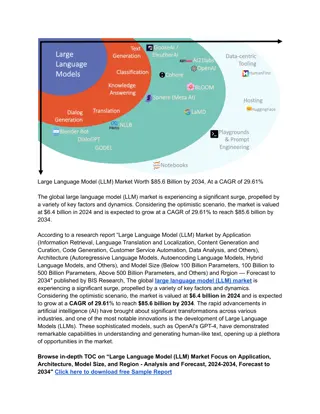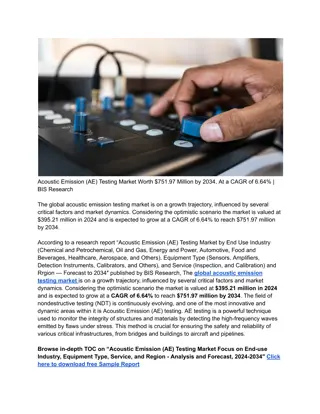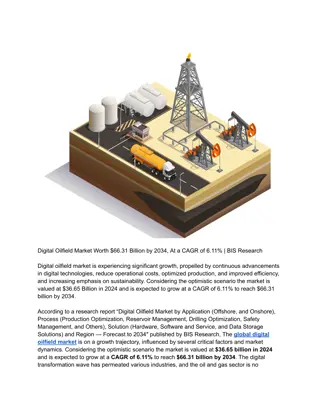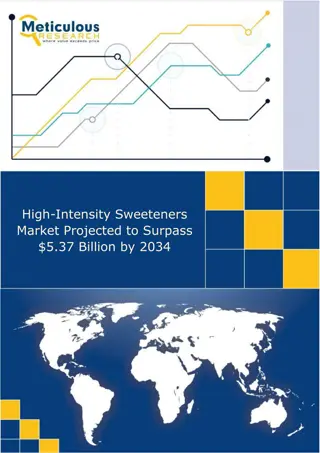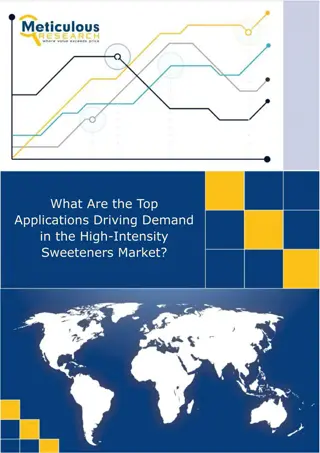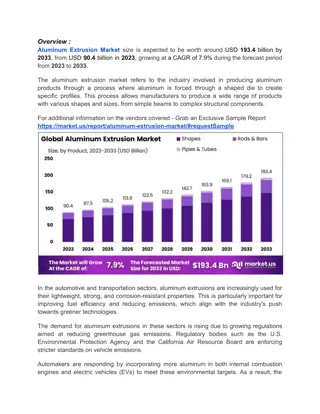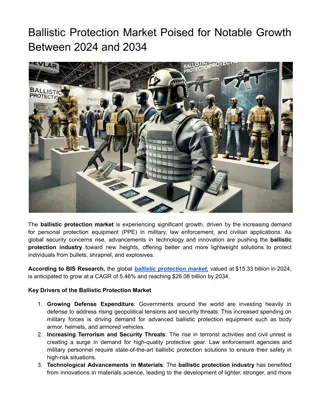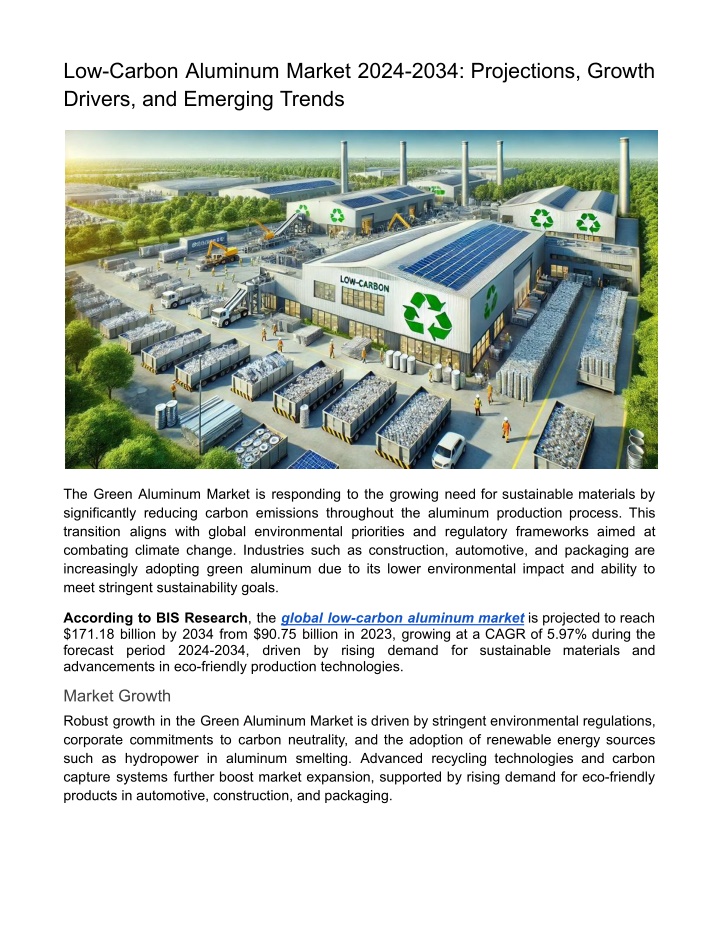
Low-Carbon Aluminum Market 2024-2034: Projections, Growth Drivers, and Trends
The global low-carbon aluminum market is projected to reach $171.18 billion by 2034 from $90.75 billion in 2023, growing at a CAGR of 5.97% during the forecast period 2024-2034.nnRead Report Overview: //bisresearch.com/industry-report/low-carbo
Download Presentation

Please find below an Image/Link to download the presentation.
The content on the website is provided AS IS for your information and personal use only. It may not be sold, licensed, or shared on other websites without obtaining consent from the author. If you encounter any issues during the download, it is possible that the publisher has removed the file from their server.
You are allowed to download the files provided on this website for personal or commercial use, subject to the condition that they are used lawfully. All files are the property of their respective owners.
The content on the website is provided AS IS for your information and personal use only. It may not be sold, licensed, or shared on other websites without obtaining consent from the author.
E N D
Presentation Transcript
Low-Carbon Aluminum Market 2024-2034: Projections, Growth Drivers, and Emerging Trends The Green Aluminum Market is responding to the growing need for sustainable materials by significantly reducing carbon emissions throughout the aluminum production process. This transition aligns with global environmental priorities and regulatory frameworks aimed at combating climate change. Industries such as construction, automotive, and packaging are increasingly adopting green aluminum due to its lower environmental impact and ability to meet stringent sustainability goals. According to BIS Research, the global low-carbon aluminum market is projected to reach $171.18 billion by 2034 from $90.75 billion in 2023, growing at a CAGR of 5.97% during the forecast period 2024-2034, driven by rising demand for sustainable materials and advancements in eco-friendly production technologies. Market Growth Robust growth in the Green Aluminum Market is driven by stringent environmental regulations, corporate commitments to carbon neutrality, and the adoption of renewable energy sources such as hydropower in aluminum smelting. Advanced recycling technologies and carbon capture systems further boost market expansion, supported by rising demand for eco-friendly products in automotive, construction, and packaging.
Key Technologies The Green Aluminum Market leverages cutting-edge technologies to minimize emissions and enhance sustainability: Hydropower Utilization: Replaces fossil fuels in smelting operations with clean, renewable energy, significantly lowering greenhouse gas emissions and supporting sustainability targets. Carbon Capture and Storage (CCS): Captures and stores CO2 emissions from industrial aluminum production, preventing them from entering the atmosphere and aligning with carbon neutrality goals. Advanced Recycling Techniques: Enhances the reuse of aluminum scrap, conserving energy and resources while minimizing waste, making the production process more sustainable and cost-efficient. Request A Detailed Sample in the Low-Carbon Aluminum Market! Demand Drivers Key factors propelling the market forward include: Sustainability Mandates: Global governments and industries are implementing stringent regulations and policies to accelerate the shift toward low-carbon materials, driving market adoption. Consumer Awareness: Increasing eco-consciousness among consumers is shaping demand for sustainable products, compelling industries to adapt their practices to align with environmental priorities. Corporate Sustainability Goals: Leading corporations are prioritizing investments in green technologies and low-carbon solutions as part of their strategies to meet net-zero emission targets and enhance brand value. Automotive Sector to Dominate The automotive industry is anticipated to lead the Green Aluminum Market due to the increasing demand for lightweight and fuel-efficient vehicles. Green aluminum plays a vital role in reducing vehicle emissions and achieving sustainability goals in manufacturing. Its use enhances battery efficiency in electric vehicles and supports compliance with stringent emission regulations. Additionally, automakers are increasingly partnering with aluminum producers to integrate sustainable materials into their supply chains. Key Market Producers Company Type 1 (by Source of Production): Solar Energy Vedanta Aluminum and Power Emirates Global Aluminium PJSC Capral Limited Rio Tinto China Hongqiao Group Limited
Company Type 2 (by Source of Production): Hydro Energy EN+ Group Century Aluminum Company Norsk Hydro ASA Alcoa Corporation China Hongqiao Group Limited South32 PT Indonesia Asahan Aluminium Company Type 3 (by Source of Production): Recycling EN+ Group Century Aluminum Company Emirates Global Aluminium PJSC Norsk Hydro ASA Constellium SE Company Type 4 (by Source of Production): Carbon Capture and Storage (CCS) (Planned) Aluminium Dunkerque Norsk Hydro ASA Conclusion The Green Aluminum Market is set to experience remarkable growth as industries worldwide prioritize sustainable practices. Technological advancements in renewable energy, recycling, and emission reduction position green aluminum as a cornerstone of eco-friendly manufacturing in the coming decade. BIS Research, recognized as a best market research company, provides premium market intelligence reports on deep technologies poised to cause significant market disruption in the coming years. At BIS Research, we focus exclusively on technologies related to precision medicine, medical devices, diagnostics, life sciences, artificial intelligence (AI), machine learning (ML), Internet of Things (IoT), big data analysis, blockchain technology, 3D printing, advanced materials and chemicals, agriculture and FoodTech, mobility, robotics and UAVs, and aerospace and defense, among others.

![Global Medical Robots Market Research Analysis & Forecast [2024-2034]](/thumb/86013/global-medical-robots-market-research-analysis-forecast-2024-2034.jpg)
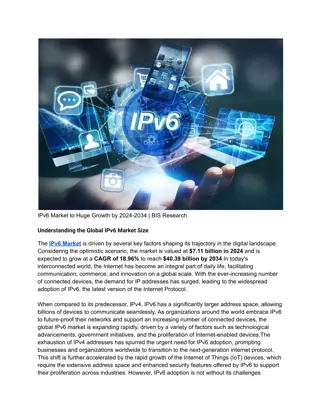
![Mass Notification System Market Size, Report & Forecast _ BIS Research [2024-2034]](/thumb/86971/mass-notification-system-market-size-report-forecast-bis-research-2024-2034.jpg)
